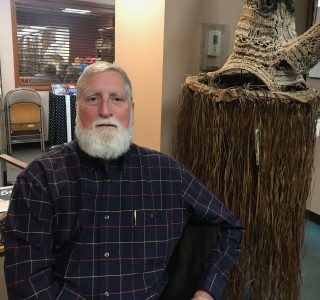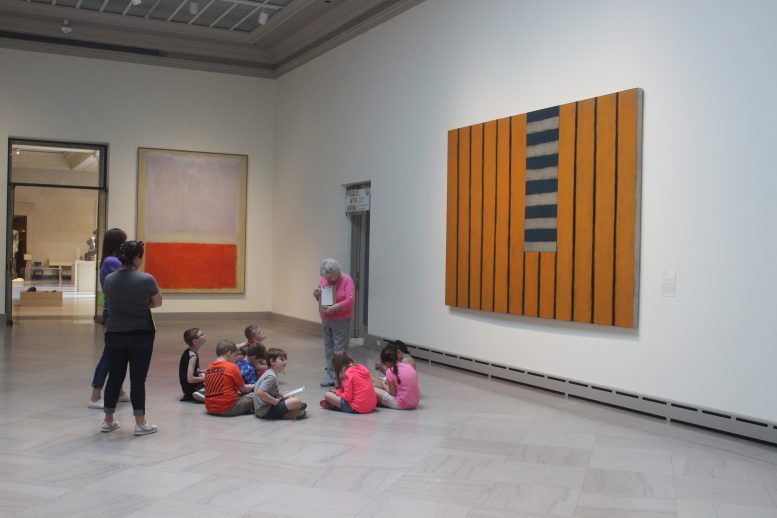By DAVID DUPONT
BG Independent News
After teaching at the university level for 40 years, Mike Coomes, is ready to graduate again.
Coomes is a member of the most recent class of Toledo Museum of Art docents, and a ceremony will be held Jan. 23 to mark the end of their year-long training.
The museum is recruiting for a new class that will begin training later this year. Information sessions will be held Friday, Jan. 17, from 10 a.m. to 12:30 p.m. and Wednesday, Jan. 22 from 5:30-7:30 p.m. in the Little Theater.
“Docents are trained Toledo Museum of Art volunteers who engage with visitors to encourage enjoyment of the arts and create a warm and welcoming museum environment,” explained Mike Deetsch, TMA’s director of education, in an announcement about the new class.

Coomes and those in his class, and those in the forthcoming class, are coming in specifically to lead with tours for students in grades kindergarten through 8.
That brings him back to where his teaching began. Before going into higher education, he taught and coached in a small parochial school. Trained to teach high school, he admitted he was a not very good middle school teacher. He lasted a year.
Now he’s back learning new tricks to capture students’ attention.
That may be with a spooky painting by Joan Miro, or a grand historic pageant like “The Oath of Horatio” by Jacques-Louis David.
Coomes retired from Bowling Green State University where he taught Higher Education and Students Affairs in College of Education and Human Development about four years ago, though he has continued to teach.
Being a Toledo Museum docent “gives me an opportunity to do something in retirement that allows me to continue to teach, be in a museum environment, and share what I know and what I am learning about the museum’s collection with others.”
Dianne Klein timed her retirement from Bowling Green High School so she could join a docent class. She taught English and, with the late choral director Jim Brown, a Humanities through the Arts course. She would bring the Advanced Placement English students to see special exhibits and the Humanities students went for an afternoon monthly.
Susan Palmer, the director of docents worked with them, and Klein knew that Palmer was moving on to another position in the museum, and she would be teaching one more class. Klein wanted to train with Palmer.
That was back in 2004. Now as master docent — the title is reflection, she said, of longevity not greater expertise— she has conducted hundreds and hundreds of tours.
They involved school kids and grandparents and all ages in between. Recently she was an “ask-me” docent where she had spontaneous interactions with visitors.
Klein appreciates the museum’s outreach, which former director Brian Kennedy pushed, to draw in a more diverse audience in terms of income, ethnicity, and age.
She and Sharon Hanna lead a gallery group of fellow residents from Bowling Green. The group Klein noted was started by Betty Laukhuf, when she was a docent. Laukhuf remains a member of the group.
Hanna has been a docent since 2012. “The very night I retired from a busy career, I came to the museum to listen to four persuasive docents describe the program. I thought it would be a purposeful way to use time that I could finally offer. It has been that, and so much more,” she wrote in an email. Hanna worked in development for BGSU and later in university advancement at the University of Toledo.
Both Klein and Hanna noted that they’ve developed new friendships through being docents.
They will travel to museums across the country together, and sometimes get access to private collections, Klein said.
Being a docent requires constant education with monthly training sessions and orientation with the curators. Hanna cited “being an active life-long learner” as one of the benefits of being a docent.
“I see new stuff every time I go there,” Coomes said. As part of his training he researched and wrote about “Open Air Breakfast” by William Merritt Chase, “the greatest American artist I’d never heard of.”
While the tours are planned, sometimes they require last minute adjustments, he said. Another group may be camped out in front of the work he intended to discuss, so he’ll have to select another piece. Or maybe the piece he chose isn’t working for students.
The school tours Coomes leads are tied into the curriculum
“A lot of schools in area don’t have art programs,” Coomes said. In Bowling Green “we’re very lucky.” However, “Toledo Public has a very limited art budget. We want to get them into the museum and introduce them to visual literacy, connecting art to real life. We’re filling a gap, especially for little ones.”
The K-2 students concentrate on shapes, textures, and lines. After visiting the galleries upstairs they go and create their own art in a studio downstairs.
The program for grades 3-5 is focused on writing skills. They have to look closely at a painting and then they write a poem describing it.
The focus for grades 6-8 is social studies.
The museum staff worked closely with local teachers to design that curriculum so it aligns with state standards. The docents aren’t expected to teach about the historic and mythological figures from the past. Instead they are told: “We want you to bring them to life.”
So they go into the court filled with antiquities.
Coomes remembered one girl being “dumbfounded” when she realized these really were 300-year-old objects.
While most docents are retired, Klein said, a few do manage to fit it into a working schedule.
“You don’t have to know about visual literacy or art history,” Coomes said. “You learn that. They want people who are sensitive to the arts and understand the value the arts play in a community.”

